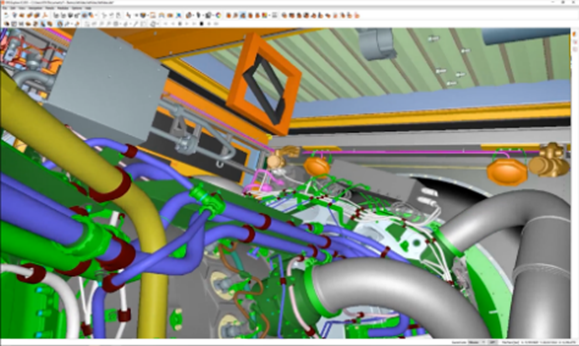Rolls-Royce Accelerates Digitalization to Power Sustainability
How Virtual Reality contributes to reducing the carbon footprint of product development activities for defense programs at Rolls-Royce

Aerospace enterprises are racing to launch their latest sustainable flight & air mobility innovations. Reduced emissions, new energy sources, and emerging paradigms for urban air mobility drive new engineering decisions that could introduce risks for the people who operate, build, and maintain those products.
New concepts in airframe and propulsion engineering challenge previous assumptions in aircraft design and may require brand-new architectures. What worked for the first century of powered human flight might not be appropriate for the future of air transportation. To accelerate the development of first-of- their-kind products, enterprises are leaning toward digital transformation and virtual prototyping. Unfortunately, human interactions with products in key processes, like assembly or maintenance, are often left until later in the development process when physical mock-ups and operable prototypes are available.
To speed up the delivery of innovative aircraft, keep costs down, and avoid the late discovery of inefficiencies, aeronautic OEMs understand they must leverage digital solutions. OEMs like the Boeing Company, suppliers like Latecoere, Safran Group and Rolls Royce, and their extended enterprises rely on Virtual Reality software to power collaborative virtual workflows, so that teams can experience physical interactions with yet-to-be-realized aircraft designs without waiting for construction or requiring traveling to a common site.
Virtual Reality Use Case: Checking the Maintainability of Rolls-Royce’s MT30 Turbine, Ahead of Production

To give you a sense of the benefits that VR can bring to industrial product development, I invite you to read this month’s article “Using Virtual Reality to Improve Product Development” published in SAE Aerospace & Defense Technology Magazine.
In this article co-authored with Dan Gillians, Innovation Lead & Technologist from Rolls-Royce Defense in Bristol, we explain how Rolls-Royce Defense are using our Virtual Reality software to reach their maintainability goals for the MT30 turbine. It’s an exceptional project as this specific engine, originally designed to power aircraft, is used in a variety of naval platforms across the world for military vessels.
For example, one of the problems that Rolls-Royce engineers encounter is accessibility to the engine within a limited packaging space. To improve the safety and efficiency of service tasks, Rolls-Royce engineers use IC.IDO to virtually validate these human-centric operations allowing life-like exploration and task validation. Uncovering these issues often gives a wider appreciation of integration challenges faced with cross-functional collaboration enabling product and process optimization much earlier in the development phase.
Have you ever done an immersive review of your assembly or maintenance processes?

Compared to real tests, engineering reviews with ESI's Virtual Reality software, IC.IDO, offer you these benefits:
- safer operation
- sustainability - zero hardware prototype or material waste
- remote capabilities compliment Collaborative Workflows within your company, or with suppliers and third parties
- real-time updates with the latest available product data
- seamless integration into your Digital Thread
Dive Deeper into the Key Applications of Virtual Reality Software in the Aerospace Industry
If after reading this article, you are eager to learn more on Virtual Reality in an industrial product development context, download our new eBook. You will find out how other leading aerospace companies use our Virtual Reality software to experience their future products today, to validate human-centric processes all virtually.
James is a senior technical consultant at ESI in the UK. He has a varied background in engineering, simulation & virtual reality. Within the last 5 years, his focus has been concentrated on testing human-centric products and processes with Virtual Reality. This engagement has spanned across supporting global OEMs & suppliers within aerospace, automotive & heavy industries.